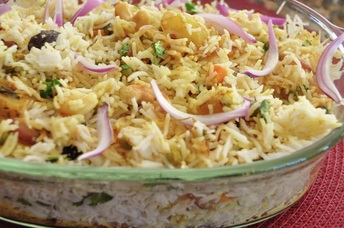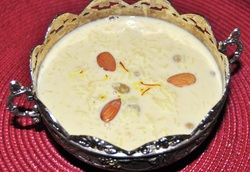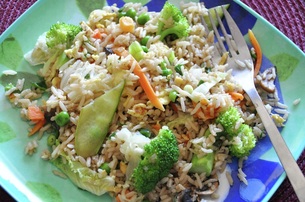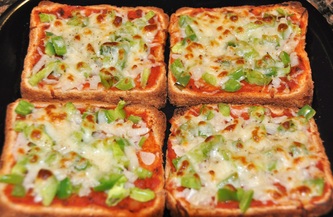My daughter’s “demand” for a pizza, the extremely cold temperatures outside prompted me to make this snack at home. First, I contemplated on picking up a phone and ordering one but then I thought of the poor delivery guy coming in sub zero temperatures. I scanned my refrigerator and took out pasta sauce, onions, bell peppers, mozzarella cheese and bread for the base. Thus, the “pizza bread” was born. My family loved it and yours will too, so go ahead and enjoy the taste of homemade pizza.
Recipe
 Vegetable Biryani Vegetable Biryani is a rich and exotic rice dish with spicy vegetables and is a perfect feast for any occasion or a party. Even though it takes a lot of time to prepare this, the final dish is all worth the effort.
Biryani is a rice-based dish made with spices, meat/fish/eggs/vegetables. It originated in Iran (Persia) and it was brought to India by Persian travelers and merchants. Biryani is derived from the Persian word 'Beryan' which means 'Fried before Cooking'. In the olden days, rice was fried (without washing) in Ghee. It did two things: It gave the rice a nutty flavor and it burned the outside starch layer gelatinizing it. After the rice is stir-fried, it was boiled in water with spices till half cooked.In an earthen pot called Handi, the rice and meat/vegetables are layered; bottom and top layer are always rice. An interlayer of some condiments may be introduced between the meat and the rice. Cardamom, Mace, Screwpine essence, rose water may be added to give flowery and herbal aroma. The Handi is sealed and put on the coal embers to cook. For Calicut Biryani, the Handi is placed on the embers produced by coconut shell. The seal is broken only when ready to serve.What type of rice to make Biryani?Historically, long-grain brown rice was used in North India; while, short grain Zeera Samba rice was used in South India. In Bangladesh, puffed rice is used. Parboiled long grain rice has following advantages:
1) Long grain rice has low Amylopectin starch, making it less sticky.
2) Parboiling makes the starch gelatinized making it further less susceptible to being sticky.
3) The brownness of the rice is due to the bran on the rice. The bran gives the 'chewy' texture to the grain.
Most common rice used today, is white Basmati rice.What types of vegetables are used to make Biryani?In Calcutta region, potatoes are the most common item. Cauliflower, carrots, peas, sweet bell peppers and green beans are traditional. New items include Jack fruit, Bottle gourd, and Garbanzo beans. Difference between pulao and biryani: The difference between biryani and pulao is that while pulao may be made by cooking the items together, biryani is used to denote a dish where the rice is cooked by separately from the thick sauce (curry of meat or vegetables). The curry and the rice are then brought together and layered, resulting in a dish of the contrasting flavors of unflavored rice (which has a hint of the aromas and juices of the curry) and intensely flavored sauce and meat or vegetables.Recipe
 Rice Kheer It rained and rained in Dallas for two days after months of scorching heat. And what else would celebrate the wonderful weather than “kheer and sweet puas”. This fragrant, creamy dessert garnished with dried fruit, nuts and cardamom -- and sometimes covered with a thin film of silver (which is beaten so fine that it is digestible) is well liked and very easy to prepare. Rice kheer otherwise known as rice pudding is especially popular across all of India and is eaten as a dessert at home as well prepared during many religious ceremonies. It is very versatile as it can be served warm or cold. This recipe uses "cooked rice". You can make this with your left over rice.
Recipe
 Vegetable Fried Rice I've always thought of fried rice as the quintessential comfort food. Think of it - a bowl of steaming white rice cooked to just the right consistency, filled with bits of egg and vegetable. No wonder fried rice is one of the world's most popular rice dishes!
For the home cook, the beauty of fried rice is that it is very adaptable. Like chow mein, it's perfect for those nights when you're cleaning out the refrigerator and want to get rid of any leftover vegetables.
A Bit of Fried Rice History:
While the exact origins of fried rice are lost to history, it’s believed that it was invented sometime during the Sui dynasty (589 – 618 AD), in the city of Yangzhou in eastern Jiangsu province. Yangchow (Yangzhou) Fried Rice is still the standard by which all other Chinese fried rice dishes are judged: morsels of fluffy rice tossed with roast pork, prawns, scallions and peas. In American-Chinese restaurants you’ll sometimes find it called "special fried rice."
Today, fried rice dishes are found throughout China, particularly in the south, where rice is the staple grain.
The Star of the Show – Rice:
The main key to making fried rice is using rice that has been previously cooked. Older rice is dryer, reducing your chances of ending up with a dish that is wet and gloppy. Day old rice is fine, but rice that is 2 or 3 days old is best. Rub the rice between your fingers to get rid of any clumps before cooking.
Long grain rice, which comes out fluffier and is less sticky than other types of rice, is perfect for fried rice dishes.
Instead of plain white rice, scented rice can also be used. Basmati is preferable to Jasmine rice.
Don’t Have Cooked Rice on Hand?
While nothing beats previously cooked rice for making fried rice, if you don't have any on hand, here's a tip: prepare a batch of fresh cooked rice, spread it on a baking sheet and freeze for 25 – 30 minutes. The texture of the fried rice isn't quite the same as days-old cooked rice, but it makes a handy substitute.
Cooking the Egg For Fried Rice:
There are several schools of thought on how to do this. Some prefer to fry the beaten egg and cut it into strips to use as a garnish. Others prefer to scramble the egg and mix it in with the rice – the egg is scrambled separately and added to the rice in the final stages of cooking. Either method is fine.
Cooking the Ingredients - Separately or Together?
One of the secrets of fried rice is that the ingredients are cooked separately - helping them maintain their distinct flavors - and then combined in the final stages of cooking. There’s no question that it’s easier to do this if you remove each ingredient from the pan after cooking and then add it back at the end, as in this recipe for fried rice. But the choice is up to you. If you leave all the ingredients in the pan, make sure each is cooked before adding the next – the vegetables lightly stir-fried, the egg fully set (if you’re scrambling the egg instead of adding it as a garnish), etc.
What about Seasonings?
Purists will often argue against adding any seasonings (except perhaps a pinch of salt) believing all the flavor should come from the stir-fried ingredients. However, whether or not to season fried rice is really a matter of personal preference. If you do decide to season the dish with soy sauce or oyster sauce, go lightly at first and then add more if needed.
When to Serve Fried Rice?
Fried rice can be served either as a main dish or side dish. Simple fried rice, without any meat or seafood, makes a nice substitute for plain cooked rice at an evening meal. At Chinese banquets, fried rice is frequently served at the conclusion of the main meal, before the dessert course.
Recipe
|





 RSS Feed
RSS Feed